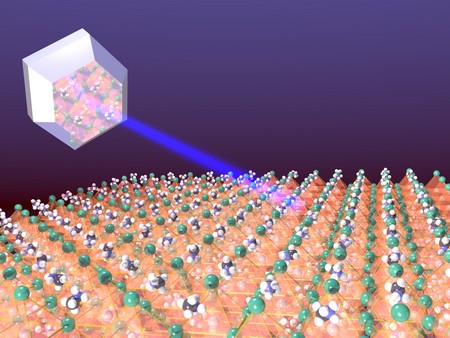Photons with energy higher than the ‘band gap’ of the semiconductor absorbing them give rise to what are known as hot electrons. The extra energy in respect to the band gap is lost very fast, as it is converted into heat so it does not contribute to the voltage. University of Groningen Professor of Photophysics and Optoelectronics Maria Antonietta Loi has now found a material in which these hot electrons retain their high energy levels for much longer. This might make it possible to use more of their energy to obtain a higher voltage.
The efficiency of solar panels is hampered by a Goldilocks problem: photons need to have just the right amount of energy to be converted into free electrons, which contribute to the voltage. Too little energy, and the photons pass right through the solar panel. Too much, and the excess energy disappears as heat.
Perovskites
The latter is due to the creation of hot (high-energy) electrons. Before they can be extracted from the solar cells, these hot electrons first give off their excess energy by causing vibrations in the crystalline material of the solar panel. ‘This energy loss puts a limit to the maximum efficiency of solar cells’, explains Loi.
She is working on a special type of solar cell that is made of organic-inorganic hybrid perovskites. Perovskites are named after a mineral that has the chemical formula ABX3. In the X position, anions form an octahedron, while in the A position cations form a cube around them, while a central cation takes the B position. Many materials in the perovskite family adopt this crystal structure. Hybrid perovskites contain organic cations in the A position.
Lifespan


prof. Maria Loi | Photo Sylvia Germes
Most hybrid-perovskite solar cells contain lead, which is toxic. Loi’s group recently published a paper describing a record-breaking nine-percent efficiency in a hybrid-perovskite solar cell containing harmless tin instead of lead. ‘When we studied this material further, we observed something strange’, she continues. The results could only mean that the hot electrons produced in the tin-based solar cells took about a thousand times longer than usual to dissipate their excess energy.
‘The hot electrons gave off their energy after several nanoseconds instead of some hundred femtoseconds. Finding such long-lived hot electrons is what everybody in this field is hoping for’, says Loi. Their longer lifespan makes it possible to harvest these electrons’ energy before it turns into heat. ‘This means we could harvest electrons with a higher energy and thus create a higher voltage in the solar cell.’ Theoretical calculations show that by harvesting the hot electrons, the maximum efficiency for hybrid-perovskite solar cells could increase from 33 to 66 percent.
Clean energy


Laserlight exciting the hybrid perovskite | Illustration Arjen Kamp
The next step is to find out why the tin-based hybrid perovskite slows down the decay of hot electrons. Then new perovskite materials could be designed with even slower hot electrons. ‘These tin-based perovskites could be a game changer, and could ultimately make a big contribution to providing clean and sustainable energy in the future.’



















